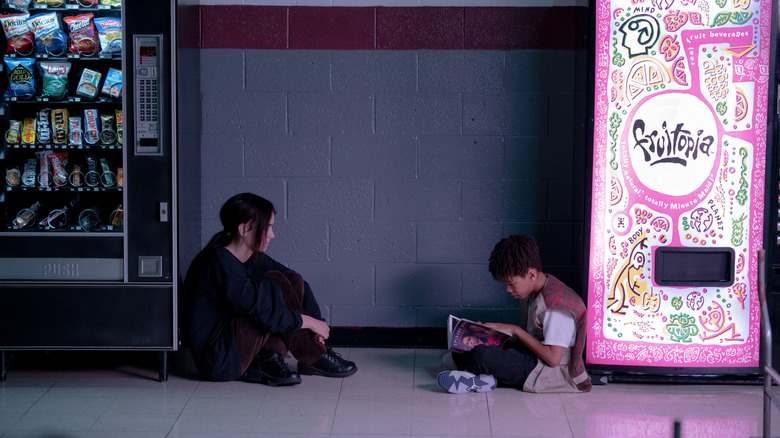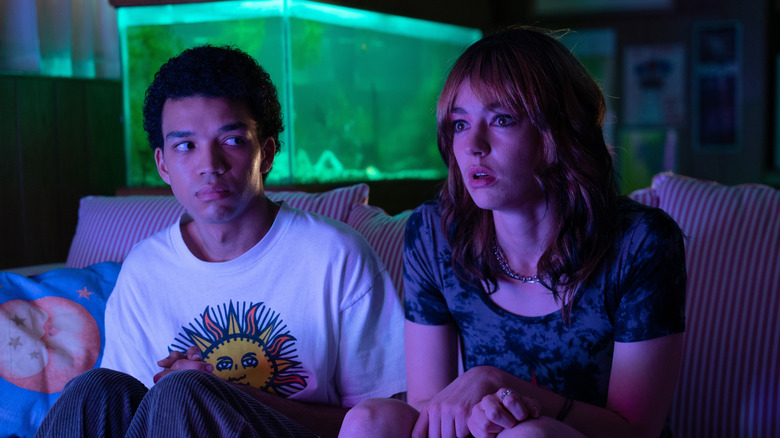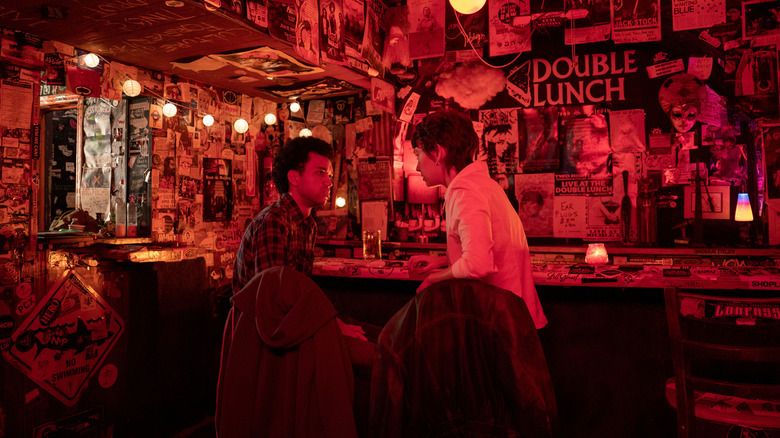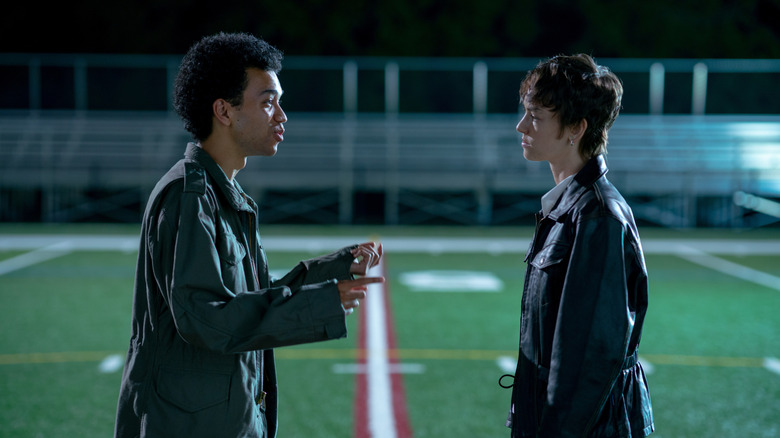I Saw The TV Glow Ending Explained: There Is Still Time
Some movies are designed to leave you feeling interrupted, intentionally cutting to credits before providing the resolution you've been craving for the last two hours. Others, especially when it comes to sci-fi, fantasy, and horror, drive their narratives and mythologies toward a specific thematic landing zone, punching it through the screen to in the final moments. "I Saw the TV Glow" is somewhere in the middle — a millennial-retro, aesthetically driven horror movie that blends heartfelt genre homage with heart-wrenching gender allegory.
If you've seen the film, you may have walked out of the theater at the end, or out of your living room, feeling like the air had been sucked straight out of you. Suffocation is a major idea throughout "I Saw the TV Glow," and it underlines the resounding horror of the ending. At the same time, the film's final moments aren't all terror. There's catharsis as well, and an open note going into the credits that leaves room for optimism, gasping for air though it may be.
For as loaded as the ending is, "I Saw the TV Glow" can lull you at times into a false sense of speed. It takes about half the movie for the plot to truly reveal itself, and even then, a lot of the biggest scenes are anchored more by tone, look, and feel than by the progression of the story. There are hints of "Twin Peaks" and David Lynch films — a major inspiration for writer-director Jane Schoenbrun — but also, the slow pace fits with the film's larger focus on time distortion.
What you need to remember about the plot of I Saw the TV Glow
At face value, "I Saw the TV Glow" is about a boy named Owen (Justice Smith and Ian Foreman) who bonds with an older girl named Maddy (Brigette Lundy-Paine) over their shared interest in a late-night young-adult fantasy show called "The Pink Opaque." The story begins in 1996, drawing heavy inspiration from "Buffy the Vampire Slayer" for its fictional TV show. But things get much stranger after Maddy disappears, only to pop back up years later with a huge revelation for Owen.
She tells him that they are actually the protagonists from "The Pink Opaque." Owen is Isabel (Helena Howard), and Maddy is Tara (Lindsey Jordan). During the events of the show's season 5 finale — the last episode before cancellation — both girls are buried alive by the villainous Mr. Melancholy (Emma Portner) and trapped in the Midnight Realm. In this magical prison, the two heroes have different names, bodies, and lives, but the world around them isn't real — just another fiction created to subdue them. Their memories are transposed onto a TV show in this realm, hiding the truth that the show is their reality and the "real world" is their cage.
Maddy, reclaiming her identity as Tara, claims to have escaped by burying herself alive and says she's returned to help Owen/Isabel do the same. But it's too much for Owen to take, and he refuses, running off and never seeing her again.
What happens at the end of I Saw the TV Glow?
The final act of "I Saw the TV Glow" fast-forwards through decades of Owen's life. We're told that his father dies and that Owen eventually starts a family of his own, whom, in an unsettling moment of direct narration, he assures us he loves "more than anything." Of course, we never see the family. We only see Owen wasting away in his nightmarish forever job at the Fun Center, "refilling the ball pit with balls," until he becomes an old man, frail and struggling to breathe, even with the help of his inhaler.
Overcome by the sudden realization that he's dying, Owen screams in the middle of a kid's birthday party at work, venting a lifetime of pent-up pain and grief. The guests and his coworkers all slip into a comatose state, leaving him alone with his anguish. Afterward, Owen goes to the bathroom and slices his chest open with a box cutter. When he peels the skin back in the mirror, all he can see is the bright glow of TV static buzzing inside him, which he seems to respond to with a combination of joy, terror, celebration, and sadness.
In the final shot, Owen walks out across the main floor of the Fun Center, apologizing for his outburst to each person he passes as he continues to struggle to breathe. The movie ends before we get to see where he's going or if he'll make it out of his prison before it's too late.
I Saw the TV Glow is first and foremost a transgender allegory
There's a lot going on thematically in "I Saw the TV Glow," from commentary on our relationship with media to ideas about the overarching queer millennial experience. But at its core, it's a trans story told by a trans nonbinary filmmaker, who's said as much in multiple interviews.
"'TV Glow' is about something I think a lot of trans people understand," Schoenbrun told The New Yorker in a June 2024 profile. "The tension between the space that you exist within, which feels like home, and the simultaneous terror and liberation of understanding that that space might not be able to hold you in your true form." In an interview with Variety, they discussed the film as being about the "egg crack," a term in the trans community referring to when a person first fully acknowledges their own trans identity to themself.
Owen isn't Owen; she's Isabel, and Maddy is Tara. But as reflected by those characters' respective personalities on the "show," Tara is much more willing to accept the scary thing. As Owen, Isabel can't make herself become her true self again. She's too caught up in the mechanical circumstances of her life — her job, her family — and how those might be forever altered by embracing her real self. Of course, the effect of this fear and denial is a slow death by suffocation — the closeted experience of letting your true self be buried alive in silence.
I Saw the TV Glow is also about living vicariously through media
At one point in "I Saw the TV Glow," Maddy asks Owen if he likes girls or boys. "I think I like TV shows," is his reply.
As much as the film is primarily a story about queerness (and gender dysphoria in particular), there's also a lot of commentary on media consumption and fandom. In the lore of the film, Maddy and Owen are both drawn to "The Pink Opaque" because it holds their true memories, but their fandom also reflects how media can become a vicarious vessel for those unable to fully embrace themselves.
When Owen asks in one scene if he can stay up late to watch "The Pink Opaque," his father replies, "Isn't that a show for girls?" Schoenbrun had a similar experience watching "Buffy the Vampire Slayer" as a kid, calling the show "an obsession and a real balm for me in my adolescent years" in an interview with Screen Daily. The use of the name Tara for a character in "The Pink Opaque" is an homage to a character of the same name from "Buffy," who comes out canonically as a lesbian in one of the show's more culturally groundbreaking storylines. Amber Benson, the actor who played Tara on "Buffy" and was written off the show after the character's unceremonious death, has a small cameo in "I Saw the TV Glow."
In their youth, "The Pink Opaque" helps Owen and Maddie embrace parts of themselves that they can't live out in full. Decades later, upon a rewatch, Owen finds the show corny and not at all how he remembered it. "The dissociation, the hiding in stories and hiding in fandom, was a survival tool," Schoenbrun told The New Yorker. "You're protecting yourself from yourself to not have your entire conception of home destroyed."
I Saw the TV Glow has both sadness and hope at the end
Like a good David Lynch ending, "I Saw the TV Glow" leaves you hanging. The decision to leave Owen/Isabel in the midst of their crisis, rather than giving them and the audience the catharsis of escape, was a very intentional choice by Schoenbrun. "I think many people, even if they are sympathetic to narratives of biological-family estrangement, still want to believe in resolution or restorative reparative work," the director told The New Yorker. "And I think this does a disservice to queer people who are not in control of whether that work can be done."
At the same time that the film's ending feels unresolved and even suffocating, there's hope there too. Before "Maddy" vanishes again, she leaves a note written on the street in chalk: "There is still time." Those words feel like a refrain through the film's final act, during which you may find yourself shouting at the screen to get Owen to escape, to embrace being Isabel. There is at least some kind of half-catharsis in Owen's speaker-shattering scream — his acknowledgment, excruciating though it is, that this is all wrong. Of course, what release might come in that scene is countered by the abject silence of the world around Owen, frozen and closed off to the pain.
What has the director said about the ending of I Saw the TV Glow?
For Jane Schoenbrun, it was imperative to end "I Saw the TV Glow" in a kind of middle ground. "Anytime I get to an ending that feels tilted too much toward a happy-ending or sad-ending extreme, I start to feel like I'm not doing my job," the writer/director said in a May 2024 interview with Vanity Fair. The release of Owen opening up his body and seeing his true self is immediately contrasted by his instinct to close it again and start apologizing to the people around him — an instinct Schoenbrun felt was necessary to include.
"He literally has to open himself up and see the heart that's been taken from him, and see that it's been replaced by this signal that could be something beautiful, but also carries the ambivalence and sinister nature of the emptiness of glow," Schoenbrun told Entertainment Weekly. "This was my attempt to capture the ambivalence and overwhelming joy and possibility, but also things that feel sinister and terrifying about an egg crack." The director explained that while the titular "TV glow" is a portal of sorts in the beginning — a means of escape — it becomes more complicated as Owen grows older, leading to the duality of the film's final moments.
"I don't view it as a cautionary tale or a definitively sad ending," Schoenbrun told USA Today. "I just think it's truthful to the fact that if you've been taught your whole life to think of yourself as an impostor or apologize for being yourself like many trans people are, that instinct doesn't go away overnight."
What has the cast said about the ending of I Saw the TV Glow?
In addition to the director's extensive commentary on the deeper meaning behind "I Saw the TV Glow," certain members of the cast have also spoken out in interviews about the significance of the ending. Justice Smith, who plays Owen, didn't mince words or avoid definitive interpretations when asked about his take on the ending by GQ.
"It's validation that Maddie was right, that Owen is not himself," Smith told the outlet. "He is this other character. He is her. And when he rips his chest open and he sees all of the TV light, he realizes that Mr. Melancholy has created this fake reality where he's slowly dying because he's really underground without a heart." As for Owen's larger arc, Smith echoed Schoenburn that the fear and danger of embracing your true self is why the ending was left more ambiguous. "It's scary, I think, to make an identity change," he told GQ. "And his entire environment has, since he was a kid, conditioned him into feeling unsafe. So there's no world in which he wants to put himself in the crosshairs."
Brigette Lundy-Paine, who plays Maddy/Tara discussed the ending of their own character's arc in an interview with IndieWire. "I think she goes back into the show, I think she buries herself," Lundy-Paine told the outlet. "She just goes back in because I think she can't stay there. She has to go home."
Is there an alternate ending for I Saw the TV Glow?
Although the ending of "I Saw the TV Glow" is intentionally left open, there wa a more definitive climax left on the cutting room floor. In his interview with GQ, Justice Smith revealed that Jane Schoenbrun originally had a more cathartic ending, which would have seen Owen clearly embracing his true identity. "There's an extended ending where he comes out of the bathroom, he's apologizing to everyone for his panic attack, and as he slowly picks up speed, he runs through the arcade and the [light], and essentially, gets out," Smith told GQ. "And Jane decided to cut that and just end it on him apologizing for his existence. And so it creates this dynamic of, Will he ever get out?"
In their conversation with USA Today, Schoenbrun explained that they cut that happier ending because it didn't feel right for where Owen's character is at the end. "The catharsis never felt right; it felt unearned," the director explained. "Owen is just at a point when he's ready to start thinking about the hard thing, not make it through the hard thing."
In his interview with GQ, Smith agreed that the ending Schoenbrun ultimately went with was the right one. "Jane and I think it's actually hopeful," the actor said. "Because it's more vague, because you see his expression in the mirror, he's very happy and he's moved by the light that he sees, and there's no denying it. And so, obviously, he's apologetic to everybody, but at least he's closer to who he truly is."
A few different sequels could be in the works
In their interview with USA Today, Schoenbrun was asked about the possibility of a sequel to "I Saw the TV Glow." And while this kind of thematically driven, high-art film isn't necessarily the type designed to spawn a franchise, the writer/director said they've thought a lot about a potential follow-up.
"I always ask myself, 'Where do the characters go? Is there anywhere else after this?'" Schoenbrun said. "I do think there is something about this particular movie that needs a yang to its yin. I don't think it's something people will be expecting, but it will be something that's very much in the same world, from the other side of a looking glass." While Schoenbrun seems excited at the prospect of a sequel, they emphasized that they wouldn't want to make it for a few years, "and only if everyone else wants to do it, too. I have quietly talked to Justice and Brigette about it, so there is definitely another side of the prism I'd like to glance through."
In addition, Schoenbrun is already working on a thematic successor of sorts, but not for the big screen. Their debut novel, "Public Access Afterworld," is being published by Hogarth Books. In a statement reported by IndieWire, Schoenbrun explained that it's meant to be "the culmination of my so-called 'screen trilogy,'" which began with the director's "We're All Going to the World's Fair" and includes "I Saw the TV Glow." Schoenbrun conceived of the project as a TV series, but they turned to prose fiction when they couldn't land a deal. That struggle may have been due to the project's scale and ambition, which sounds like it could be massive.
"It's my epic and me trying to do 'Buffy,' 'Lost,' or 'Harry Potter,'" Schoenbrun told The Verge. "I've created this huge mythology about a giant cast of characters with a story that spans centuries and sprawls across alternate universes." According to the novel's official synopsis, it will involve "mysterious transmissions of a secret television network known as Public Access Afterworld that draws in a wide cast of characters."









